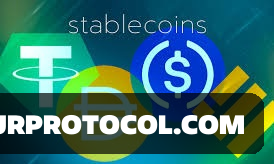Stable cryptocurrencies (called stablecoins) are digital currencies designed to keep their value stable over time. They are useful in the crypto world because most cryptocurrencies (like Bitcoin or Ethereum) are very volatile—their prices go up and down quickly. Stablecoins try to solve this problem by tying their value to stable assets like the US Dollar, Euro, or gold.
🔹 Types of Stablecoins
1. Fiat-Collateralized Stablecoins
Backed by real money (like USD or EUR) stored in a bank.
For every stablecoin issued, there's an equal amount of money stored.
Examples:
USDT (Tether) – backed by USD
USDC (USD Coin) – also backed by USD
✅ Pros: Simple and trusted
❌ Cons: Needs a centralized company to hold money, not fully decentralized.
2. Crypto-Collateralized Stablecoins
Backed by other cryptocurrencies (like Ethereum).
Use smart contracts to lock more crypto than the stablecoin’s value (overcollateralized).
Example:
DAI – backed by ETH and other tokens using MakerDAO
✅ Pros: Decentralized, transparent
❌ Cons: Can be risky if crypto market crashes.
3. Algorithmic Stablecoins
Not backed by real money or crypto.
Use software algorithms to control supply and demand.
If price goes too high, more coins are issued. If price drops, coins are removed.
Example:
Ampleforth, Frax (partially algorithmic)
✅ Pros: No need to hold real assets
❌ Cons: Hard to keep stable, many failed (e.g., Terra UST crash).
🔹 Why Are Stablecoins Important?
Safe shelter in crypto volatility
Traders move their funds to stablecoins during market crashes.
Fast and cheap transfers
Send money globally in seconds without bank delays.
Used in DeFi (Decentralized Finance)
Borrowing, lending, and earning interest all use stablecoins.
Useful in countries with high inflation
People use them to store value instead of their own unstable currency.
🔹 Risks of Stablecoins
Trust in issuer: Is the company really holding enough money?
Regulations: Governments may limit or ban stablecoins.
Technical issues: Smart contract bugs or depegging (losing the fixed value).
🔹 Popular Stablecoins:
🟢 USDT (Tether)
This is the most used stablecoin in the world. It's backed by the US dollar and is available on almost every crypto exchange. People use it for trading, sending money, and holding value. However, some people don’t fully trust it because of past concerns about transparency.
🔵 USDC (USD Coin)
USDC is also backed by real US dollars. It’s known for being more transparent and regulated. Many DeFi (decentralized finance) apps and crypto wallets prefer using USDC because it's considered safer and more reliable than USDT.
🟡 DAI
DAI is different because it's decentralized and backed by other cryptocurrencies like Ethereum. It works using smart contracts through a system called MakerDAO. It’s popular in DeFi platforms because it doesn’t depend on banks or a company to hold real dollars.
🔴 TUSD (TrueUSD)
TrueUSD is another stablecoin backed by US dollars. It’s audited regularly and is known for being very transparent. It's not as popular as USDT or USDC, but still trusted in many platforms.
Frax (FRAX)
Frax is part algorithmic and part backed by real assets. It tries to keep its value stable using both smart contracts and reserves. It’s used in some advanced DeFi platforms to earn high rewards but is riskier compared to USDC or DAI.
🟣 FDUSD (First Digital USD)
This is a newer stablecoin supported by Binance. It's replacing BUSD (which is being phased out). It’s regulated and used mainly inside Binance for trading, earning, and transfers.
How to earn interest using stablecoins?
Let’s go deeper into two areas:
🔸 How to Earn Interest Using Stablecoins
You can earn passive income by lending or staking your stablecoins. Here’s how:
1. DeFi Platforms (Decentralized Finance)
Use platforms like Aave, Compound, or Curve where you:
Lend your stablecoins (like USDC or DAI)
Earn interest paid by borrowers
Interest rate changes based on demand (can be 3–10% or more annually)
✅ Pros: No middlemen, higher returns
❌ Cons: Smart contract risks, price slippage
2. Centralized Platforms
Use services like Binance Earn, OKX, or Bybit Earn:
Deposit stablecoins for fixed or flexible earnings
Some offer up to 10–15% APY (annual % yield)
✅ Pros: Easy to use
❌ Cons: You trust the platform (if it fails, you may lose money)
3. Stablecoin Staking (Liquid Staking)
Some stablecoins (like Frax or Stader USDY) offer staking options where:
You lock your coins
Receive rewards from protocol earnings
✅ Pros: Passive yield, flexible
❌ Cons: Lower liquidity, early withdrawal penalties
4. Farming / LPs (Liquidity Pools)
Provide stablecoins in pairs (e.g., USDC/USDT) in platforms like Uniswap or Balancer:
Earn trading fees + rewards
Less risky if both coins are stable
✅ Pros: Double rewards
❌ Cons: Smart contract bugs or hacks
🔸 How to Buy Stablecoins 🪙 Step 1: Choose a Stablecoin
Popular choices:
USDT (Tether)
USDC (USD Coin)
DAI (Decentralized)
🏦 Step 2: Choose a Platform
You can buy stablecoins from:
1. Centralized Exchanges (CEX):
Examples: Binance, Bybit, OKX, KuCoin
✅ Easy for beginners
💳 Buy using bank card, bank transfer, or other crypto.
2. Peer-to-Peer (P2P) Trading:
Platforms: Binance P2P, OKX P2P
✅ Buy directly from people in your country using mobile wallets or bank transfers
3. Decentralized Exchanges (DEX):
Platforms: Uniswap, PancakeSwap
Requires crypto wallet (like MetaMask) and some ETH or BNB for gas fees.
🔸 Best Practices
✅ Use TRC20 (for USDT) or BEP20 (for BUSD/USDC) to save on fees.
✅ Double-check wallet address before sending.
✅ Use 2FA on exchanges for extra security.
✅ Don’t keep large funds on exchanges — move to your wallet.
Follow us on X : @sukra'smoon

